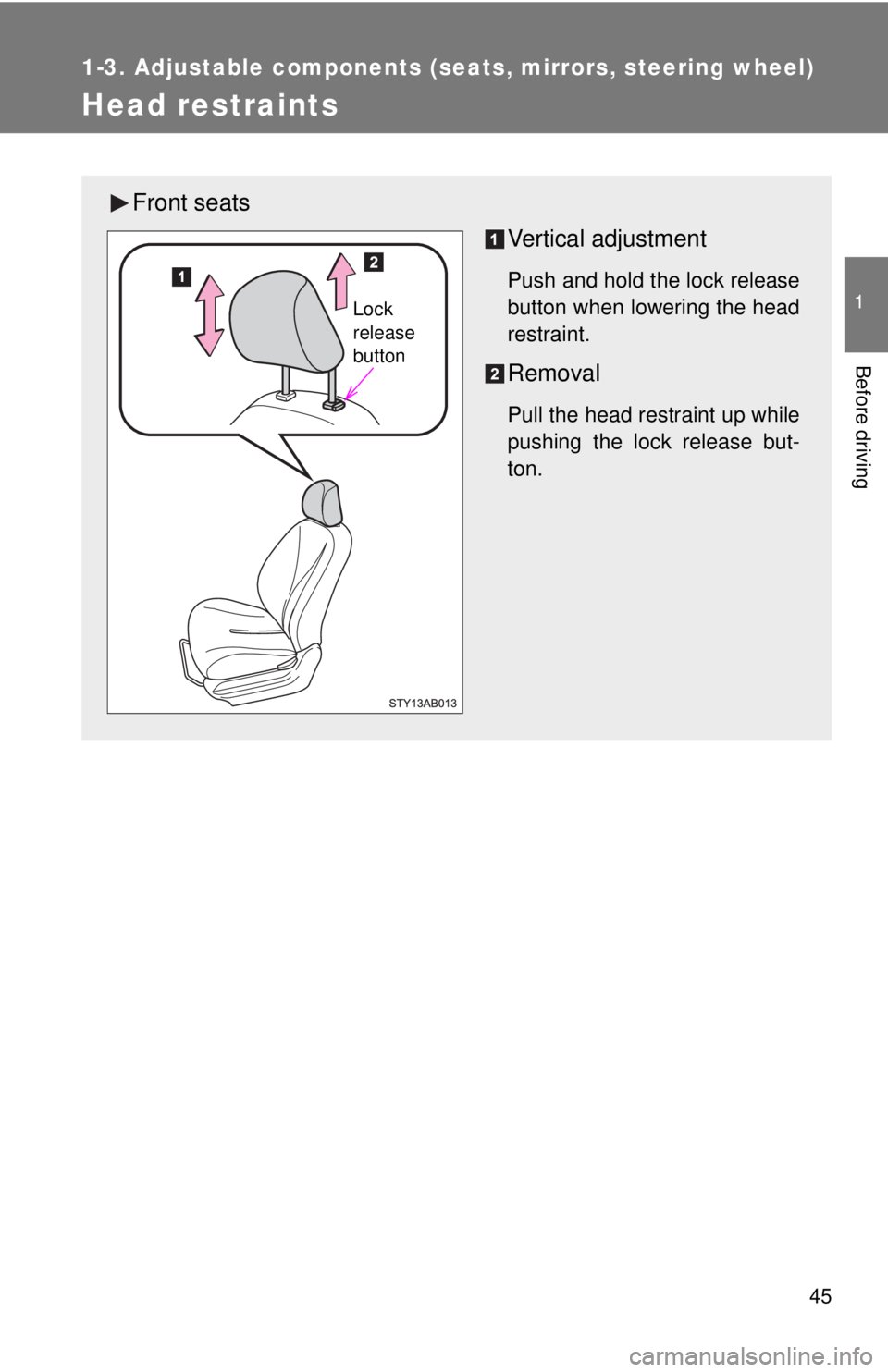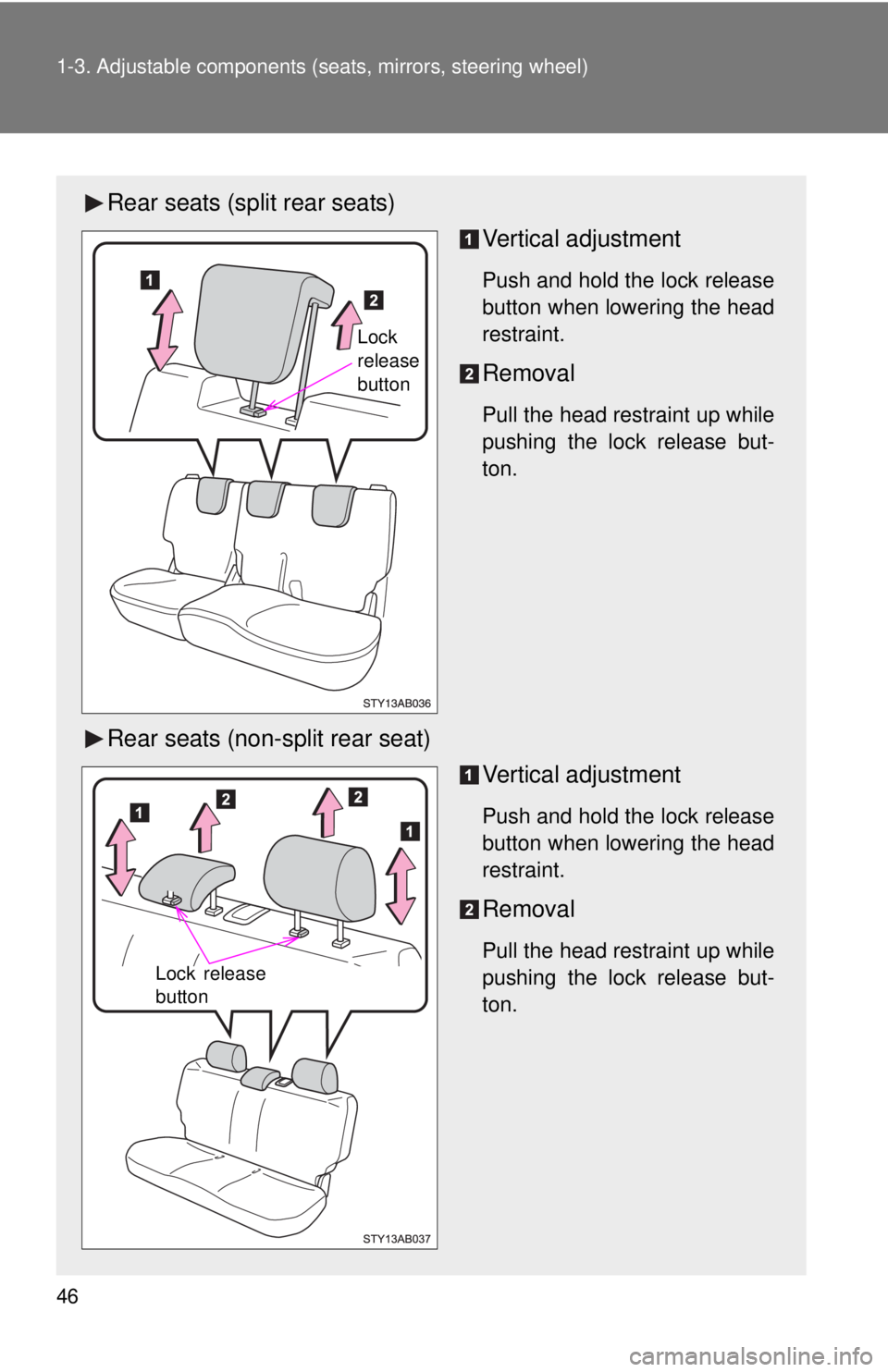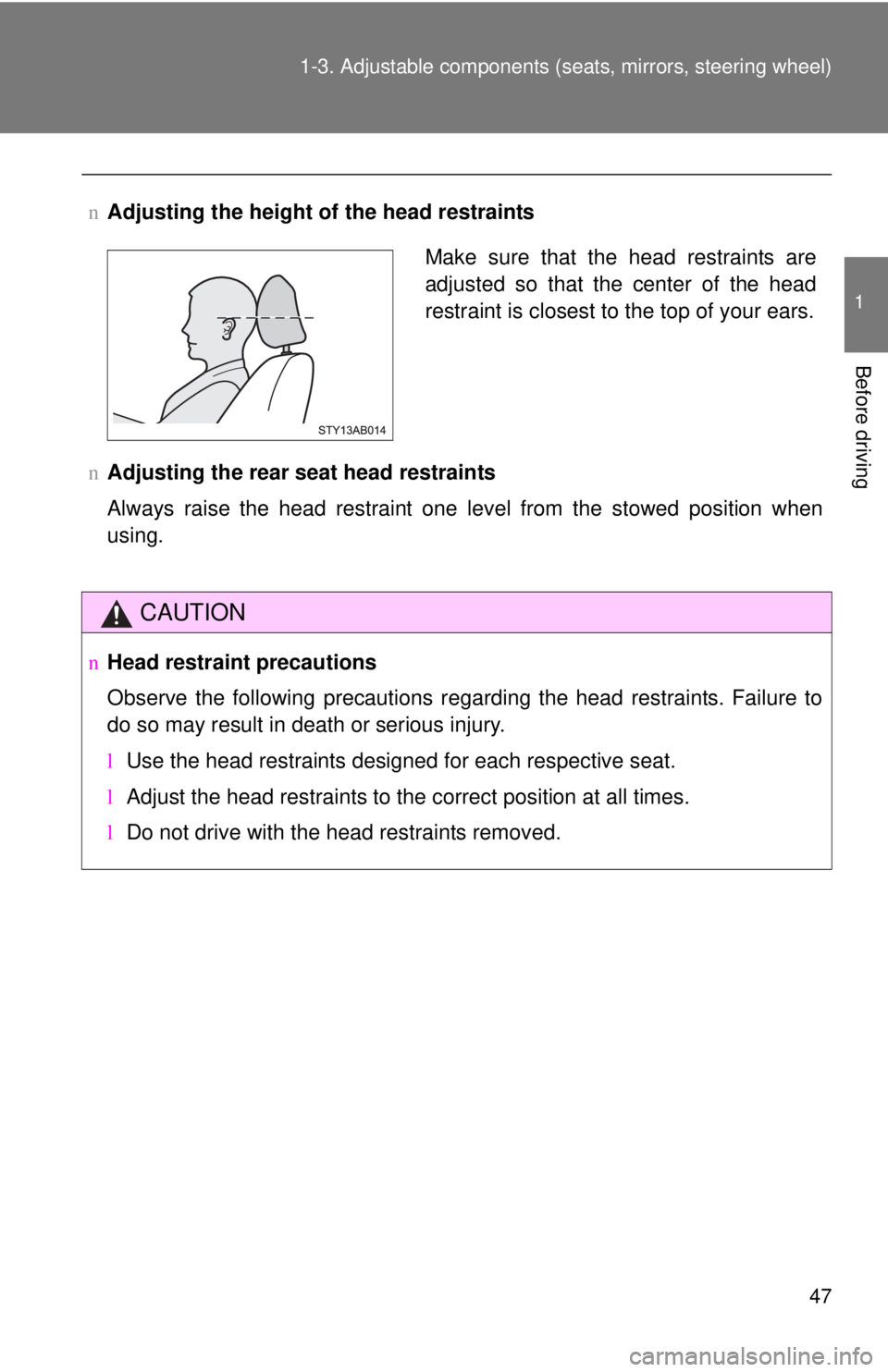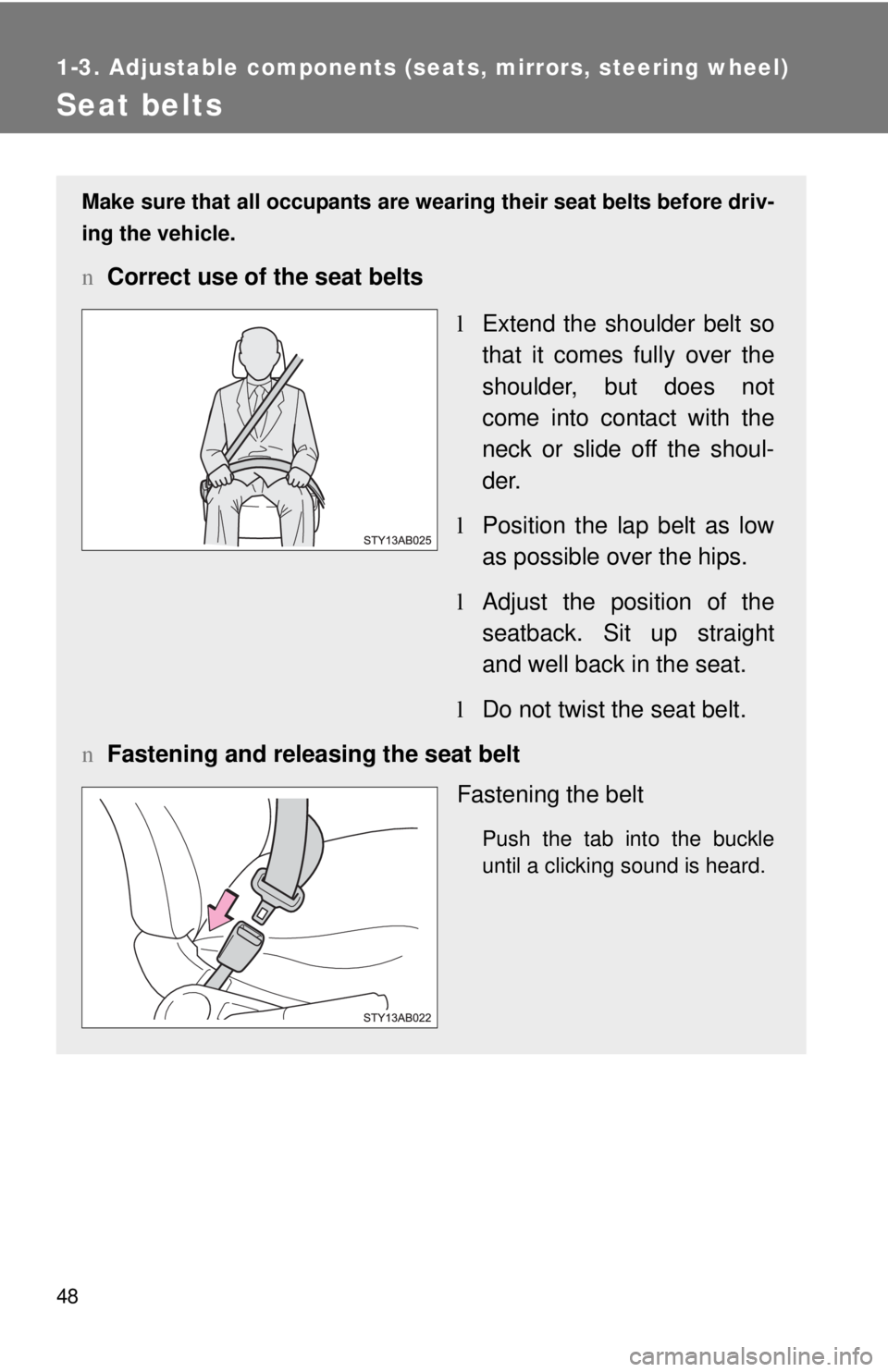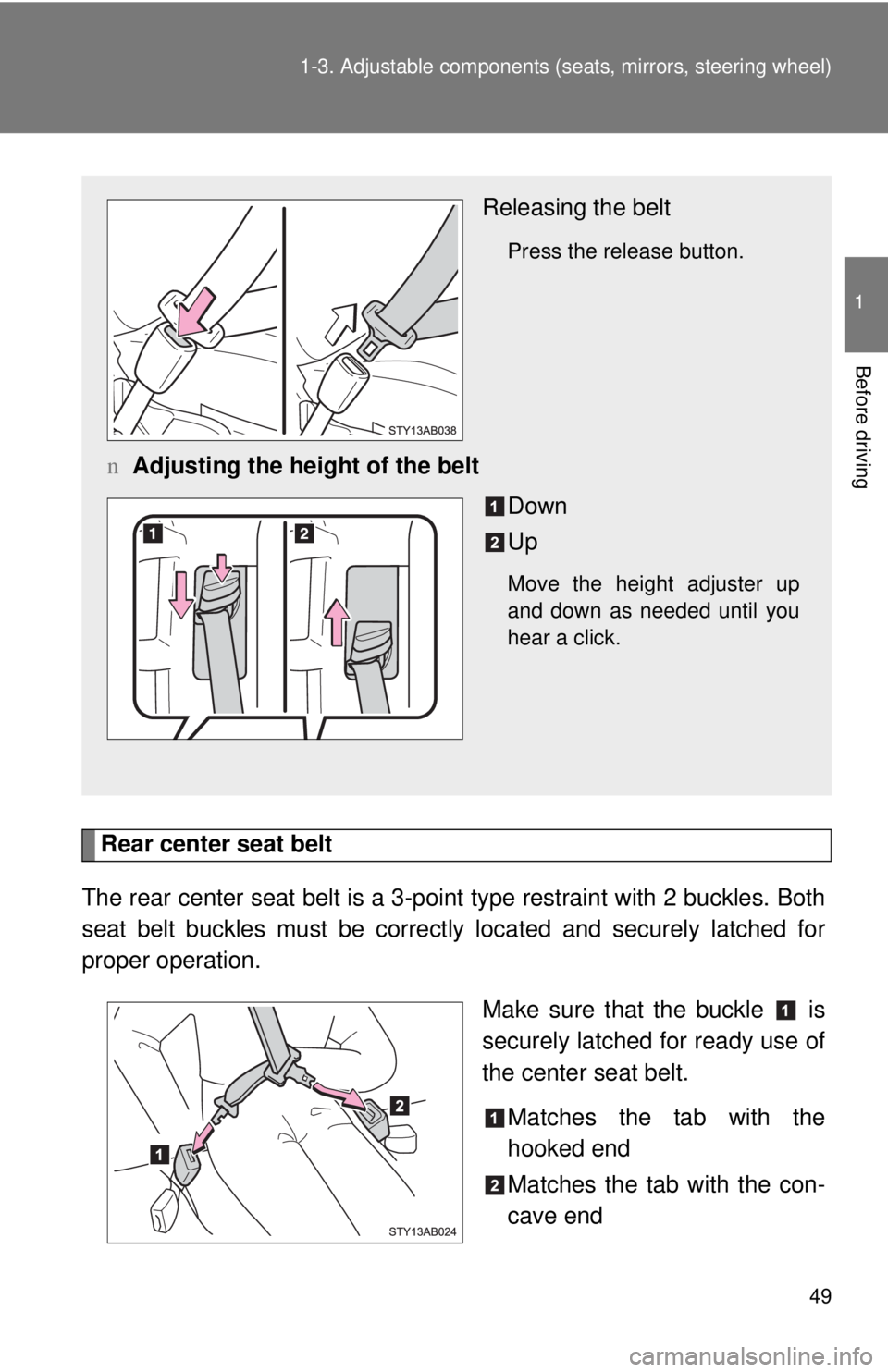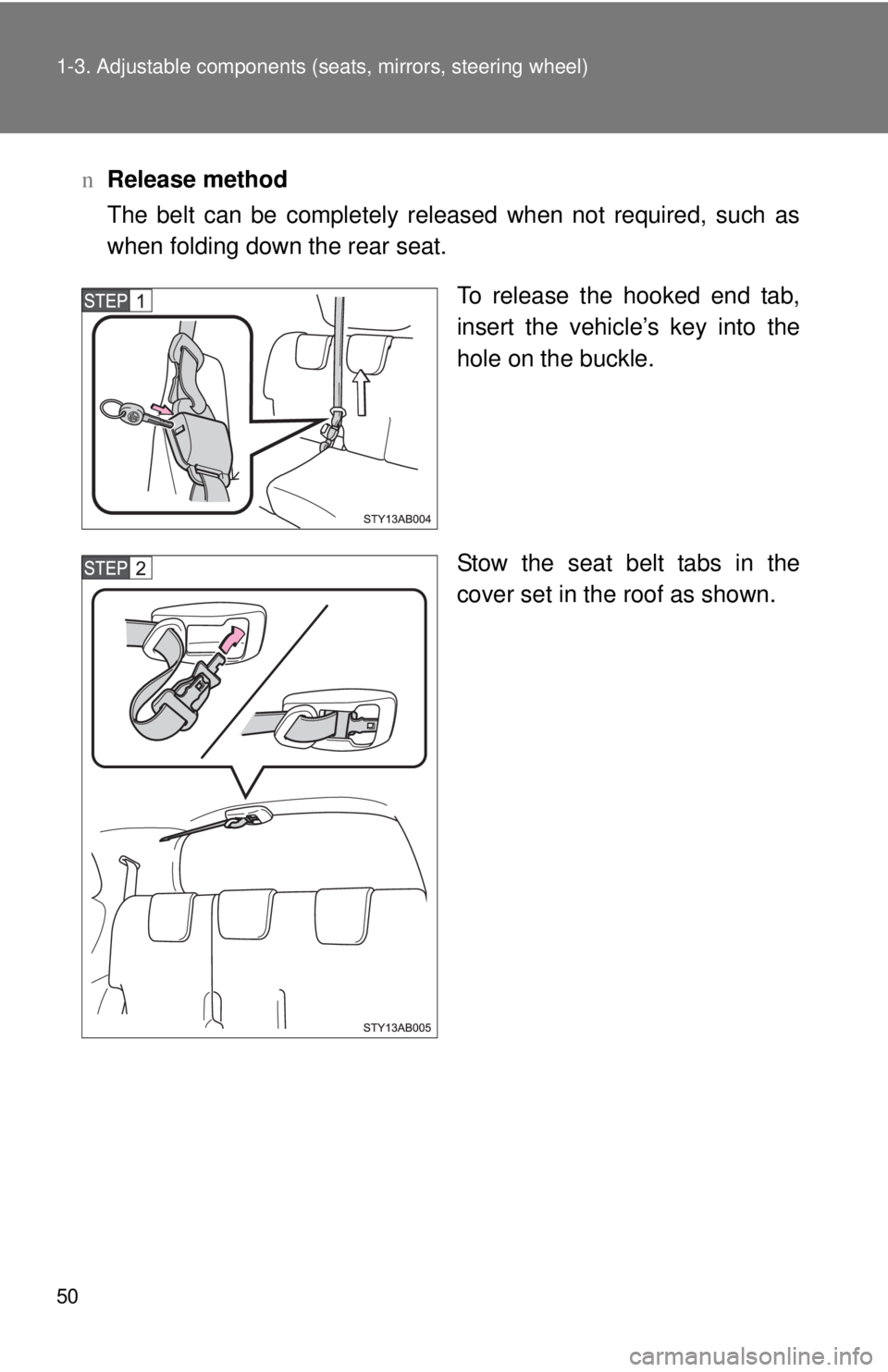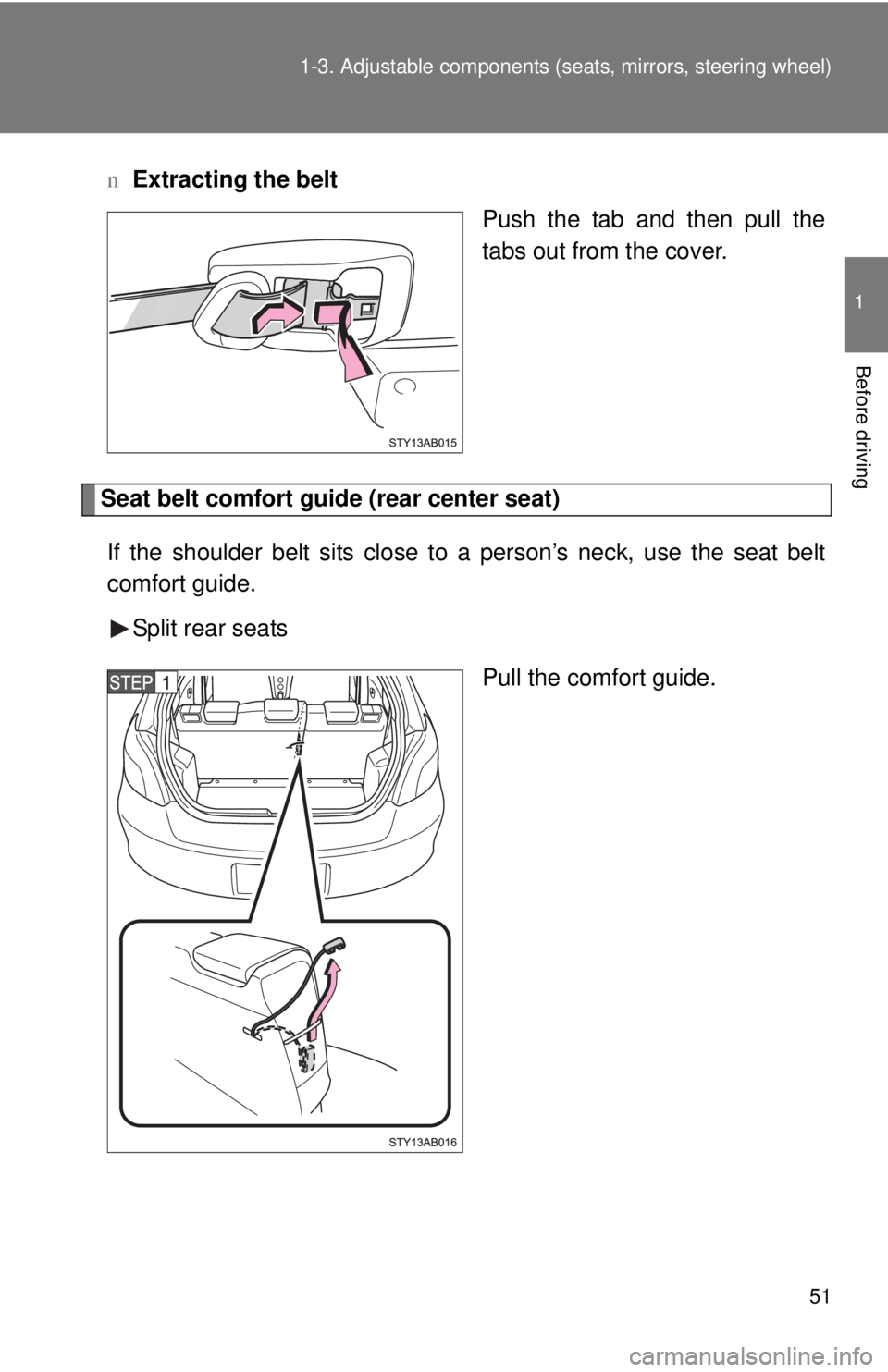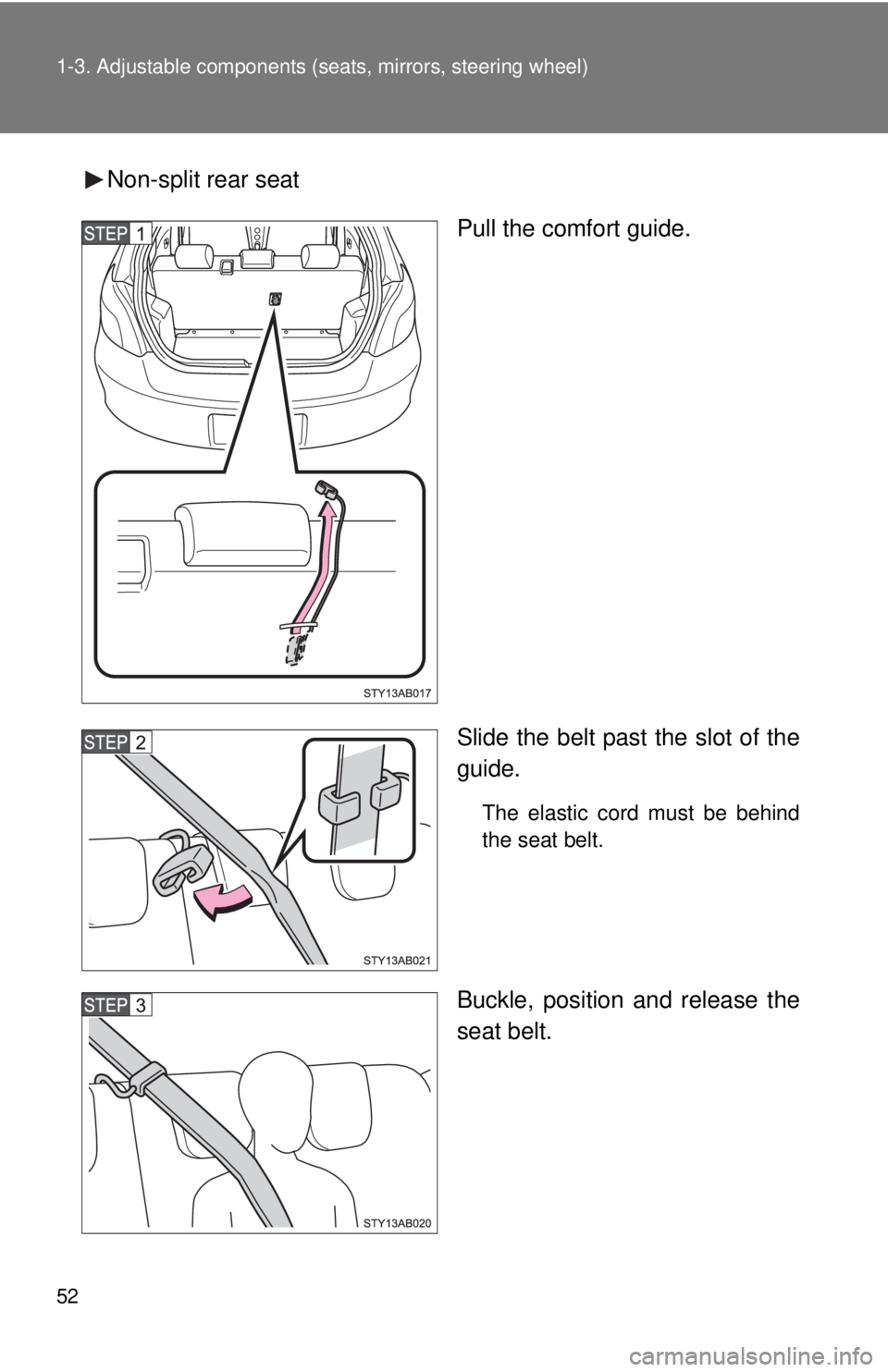TOYOTA YARIS HATCHBACK 2008 Repair Manual
YARIS HATCHBACK 2008
TOYOTA
TOYOTA
https://www.carmanualsonline.info/img/14/59275/w960_59275-0.png
TOYOTA YARIS HATCHBACK 2008 Repair Manual
Trending: brake sensor, fuel reserve, child restraint, airbag, battery, oil temperature, belt
Page 61 of 400
45
1
1-3. Adjustable components (seats, mirrors, steering wheel)
Before driving
Head restraints
Front seatsVertical adjustment
Push and hold the lock release
button when lowering the head
restraint.
Removal
Pull the head restraint up while
pushing the lock release but-
ton.
Lock
release
button
Page 62 of 400
46 1-3. Adjustable components (seats, mirrors, steering wheel)
Rear seats (split rear seats)
Vertical adjustment
Push and hold the lock release
button when lowering the head
restraint.
Removal
Pull the head restraint up while
pushing the lock release but-
ton.
Rear seats (non-split rear seat)
Vertical adjustment
Push and hold the lock release
button when lowering the head
restraint.
Removal
Pull the head restraint up while
pushing the lock release but-
ton.
Lock
release
button
Lock release
button
Page 63 of 400
47
1-3. Adjustable components (s
eats, mirrors, steering wheel)
1
Before driving
nAdjusting the height of the head restraints
n Adjusting the rear seat head restraints
Always raise the head restraint one level from the stowed position when
using.
CAUTION
nHead restraint precautions
Observe the following precautions regarding the head restraints. Failure to
do so may result in death or serious injury.
lUse the head restraints designed for each respective seat.
l Adjust the head restraints to the correct position at all times.
l Do not drive with the head restraints removed.
Make sure that the head restraints are
adjusted so that the center of the head
restraint is closest to the top of your ears.
Page 64 of 400
48
1-3. Adjustable components (seats, mirrors, steering wheel)
Seat belts
Make sure that all occupants are wearing their seat belts before driv-
ing the vehicle.
nCorrect use of the seat belts
lExtend the shoulder belt so
that it comes fully over the
shoulder, but does not
come into contact with the
neck or slide off the shoul-
der.
l Position the lap belt as low
as possible over the hips.
l Adjust the position of the
seatback. Sit up straight
and well back in the seat.
l Do not twist the seat belt.
n Fastening and releasing the seat belt
Fastening the belt
Push the tab into the buckle
until a clicking sound is heard.
Page 65 of 400
49
1-3. Adjustable components (s
eats, mirrors, steering wheel)
1
Before driving
Rear center seat belt
The rear center seat belt is a 3-po int type restraint with 2 buckles. Both
seat belt buckles must be correctly located and securely latched for
proper operation.
Make sure that the buckle is
securely latched for ready use of
the center seat belt.Matches the tab with the
hooked end
Matches the tab with the con-
cave end
Releasing the belt
Press the release button.
nAdjusting the height of the belt
Down
Up
Move the height adjuster up
and down as needed until you
hear a click.
Page 66 of 400
50 1-3. Adjustable components (seats, mirrors, steering wheel)
nRelease method
The belt can be completely released when not required, such as
when folding down the rear seat.
To release the hooked end tab,
insert the vehicle’s key into the
hole on the buckle.
Stow the seat belt tabs in the
cover set in the roof as shown.
Page 67 of 400
51
1-3. Adjustable components (s
eats, mirrors, steering wheel)
1
Before driving
nExtracting the belt
Push the tab and then pull the
tabs out from the cover.
Seat belt comfort guide (rear center seat)
If the shoulder belt sits close to a person’s neck, use the seat belt
comfort guide.
Split rear seats
Pull the comfort guide.
Page 68 of 400
52 1-3. Adjustable components (seats, mirrors, steering wheel)
Non-split rear seat
Pull the comfort guide.
Slide the belt past the slot of the
guide.
The elastic cord must be behind
the seat belt.
Buckle, position and release the
seat belt.
Page 69 of 400
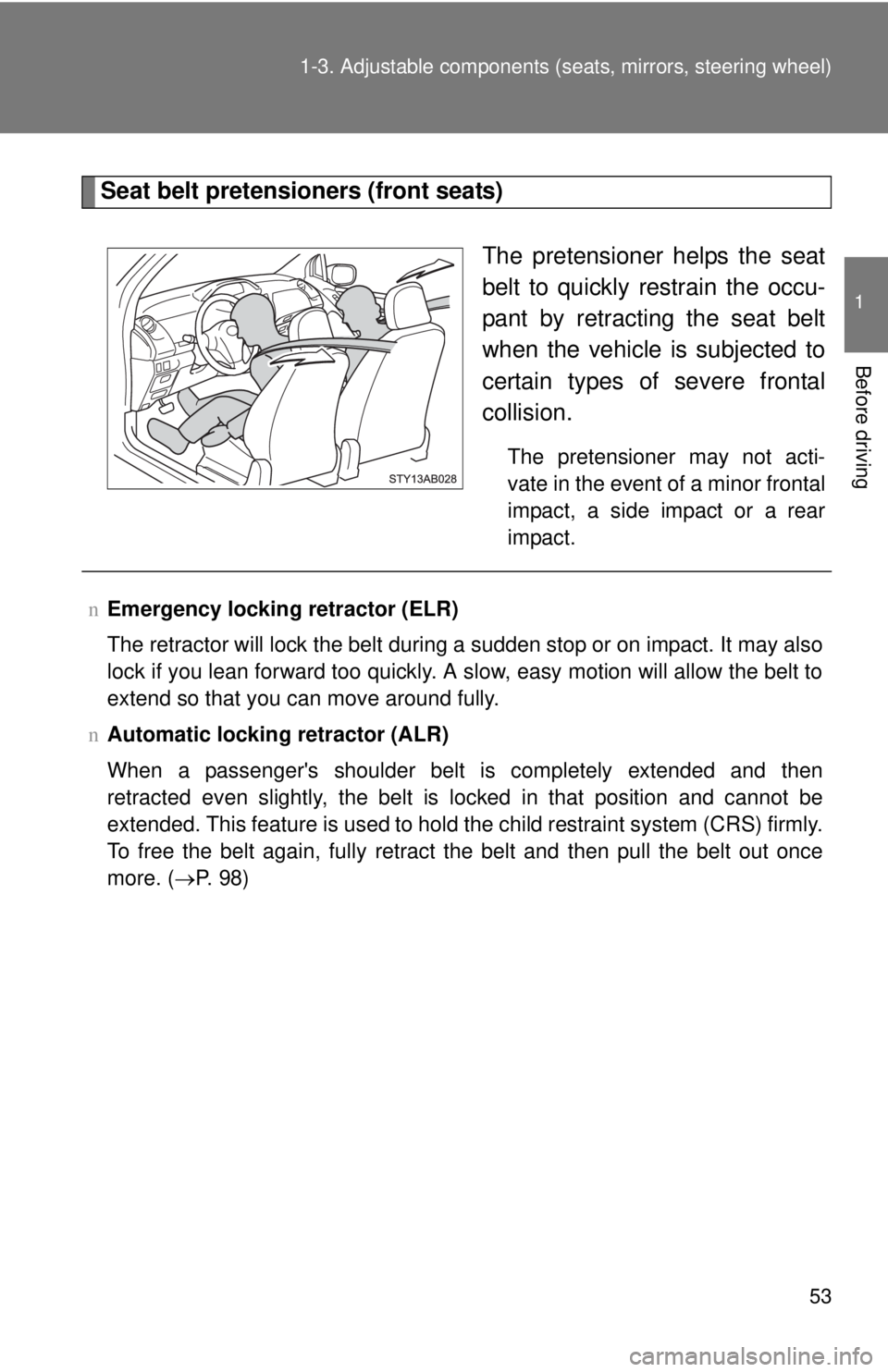
53
1-3. Adjustable components (s
eats, mirrors, steering wheel)
1
Before driving
Seat belt pretensioners (front seats)
The pretensioner helps the seat
belt to quickly restrain the occu-
pant by retracting the seat belt
when the vehicle is subjected to
certain types of severe frontal
collision.
The pretensioner may not acti-
vate in the event of a minor frontal
impact, a side impact or a rear
impact.
nEmergency locking retractor (ELR)
The retractor will lock the belt during a sudden stop or on impact. It may also
lock if you lean forward too quickly. A slow, easy motion will allow the belt to
extend so that you can move around fully.
n Automatic locking retractor (ALR)
When a passenger's shoulder belt is completely extended and then
retracted even slightly, the belt is locked in that position and cannot be
extended. This feature is used to hold the child restraint system (CRS) firmly.
To free the belt again, fully retract the belt and then pull the belt out once
more. ( →P. 98)
Page 70 of 400
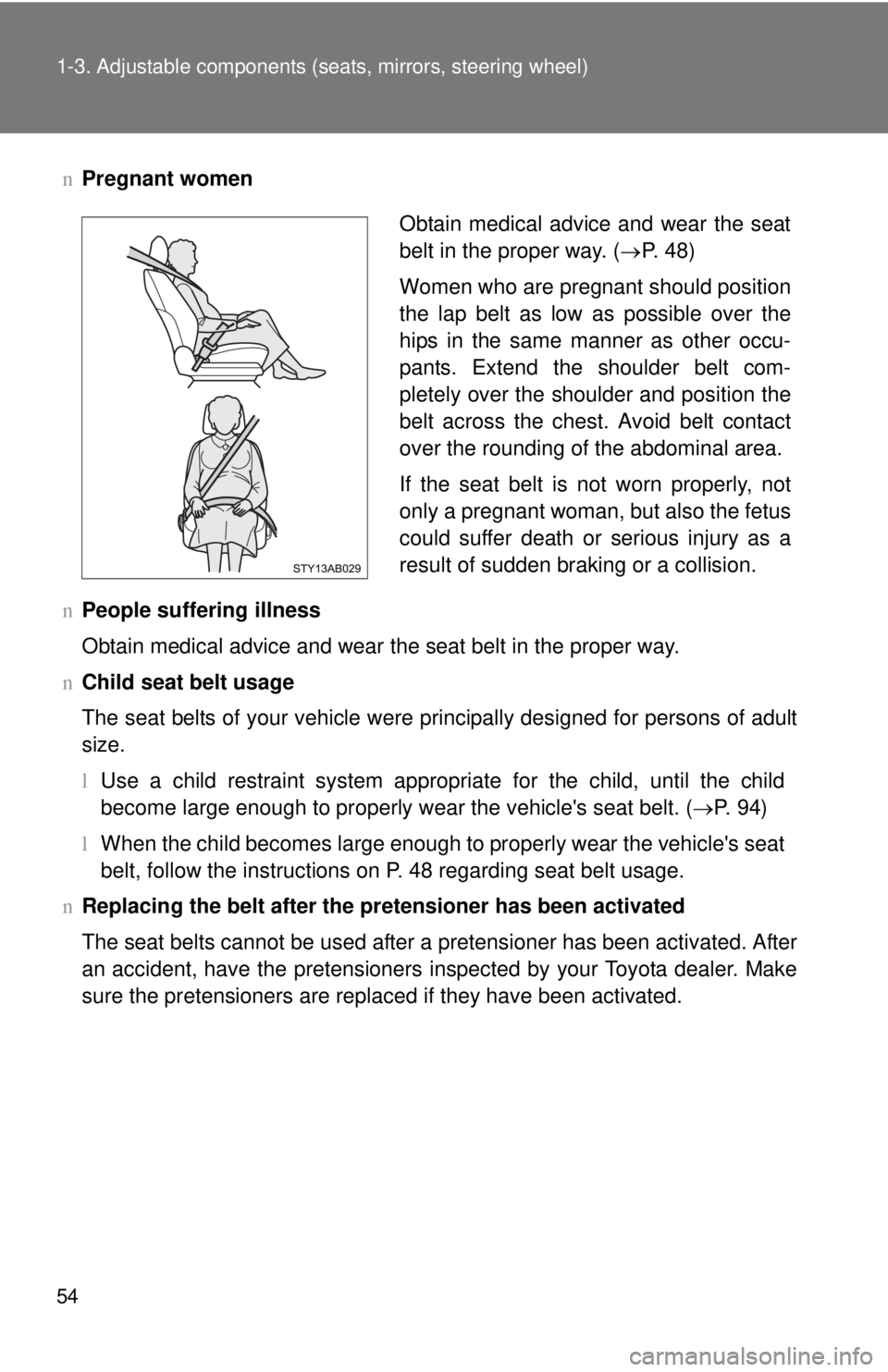
54 1-3. Adjustable components (seats, mirrors, steering wheel)
nPregnant women
n People suffering illness
Obtain medical advice and wear the seat belt in the proper way.
n Child seat belt usage
The seat belts of your vehicle were principally designed for persons of adult
size.
lUse a child restraint system appropriate for the child, until the child
become large enough to properly wear the vehicle's seat belt. ( →P. 94)
l When the child becomes large enough to properly wear the vehicle's seat
belt, follow the instructions on P. 48 regarding seat belt usage.
n Replacing the belt after the pretensioner has been activated
The seat belts cannot be used after a pretensioner has been activated. After
an accident, have the pretensioners inspected by your Toyota dealer. Make
sure the pretensioners are replaced if they have been activated.
Obtain medical advice and wear the seat
belt in the proper way. ( →P. 48)
Women who are pregnant should position
the lap belt as low as possible over the
hips in the same manner as other occu-
pants. Extend the shoulder belt com-
pletely over the shoulder and position the
belt across the chest. Avoid belt contact
over the rounding of the abdominal area.
If the seat belt is not worn properly, not
only a pregnant woman, but also the fetus
could suffer death or serious injury as a
result of sudden braking or a collision.
Trending: key battery, brake rotor, tires, jacking, water pump, tire size, warning light
